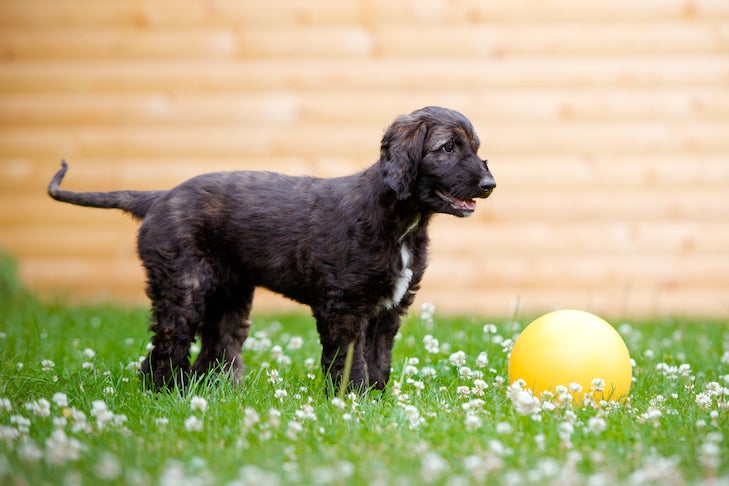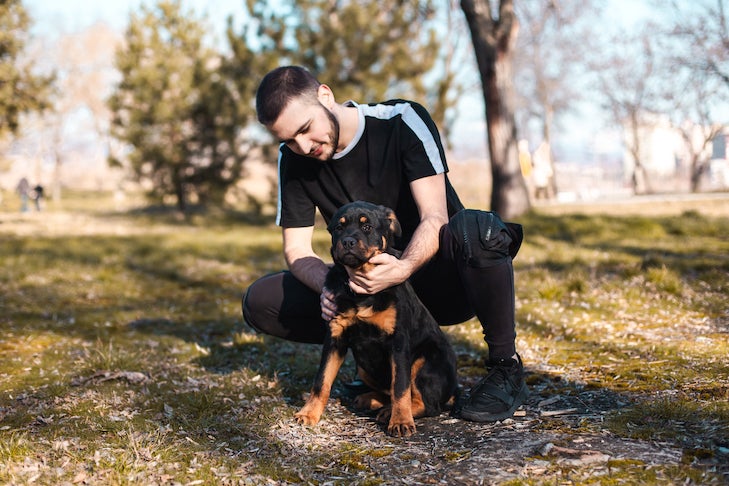
Your puppy is home and you have dreams of training and competing in sports, so where do you start? There are lots of important skills your puppy will be learning—like potty training, crate training, loose-leash walking, and basic obedience commands like sit, down, and recalls. But if you’re bored with that, or looking to do more with your sport-prospect puppy, there are games and activities that you can work on to build enthusiasm for learning.
Safety First
Just because a puppy wants to do something, or is capable of it, doesn’t mean that they should. Safety should always be your first thought when playing and training with your puppy. Talk to your breeder and your vet about what level of exercise is safe and appropriate at what age. For example, the larger your breed of puppy, the slower they will physically mature—and the longer you will need to avoid any strenuous exercise like jumping or any extended running or jogging.
Foundation Games
Even though there are many sports-related aspects of training that you shouldn’t do with a puppy, there are plenty of foundation games you can play that will help in the future. As you’re playing these games, try to reward your puppy with treats and toys. Having a puppy that can be rewarded with both food and play will be beneficial as they grow up and you get involved in more formal sports training.
1. Send to Target
Regardless of which sports you and your puppy will eventually pursue, it’s useful for them to know how to move away from you to a target. To start playing this game, put a treat (or a toy your puppy loves) a few feet in front of you where they can see it. Gently hold your puppy back and then say “ok,” or the release word of your choice, and release your puppy to get the treats, then offer lots of praise. Over time, you can move the treat/toy further away from you.
2. Line Up At Your Side
Most of us spend a lot of time rewarding our dogs for being in front of us, whether it’s teaching puppies to sit or calling them in the yard. But when they grow up, all of our puppies—particularly ones involved in sports—are going to actually spend a lot of time needing to be at our side instead of in front of us. When your puppy is young, it’s a great time to set a foundation for them being comfortable lining up at your side, and understanding that this is a position where they can and will be rewarded with toys as well as treats. Be sure to reward from both your left and right side, which is especially important for sports like agility and tricks where your dog will need to eventually take direction from both sides.
To work on this skill, start by rewarding when your puppy is next to you. You can also lure your puppy to line up at your side with a treat. At this stage, don’t worry about precision placement—this isn’t a formal return to heel position. You can add a verbal cue if you want them to line up next to you, but you don’t have to. We are focusing on just building a foundation so that the puppy knows they’ll be highly rewarded for being at our side.

3. Keep Attention
Arguably the most important thing your puppy will ever learn for their future in sports is to ignore distractions and pay attention to you. This subtle skill will allow you to walk your puppy in a busy park or down a crowded sidewalk, attend training classes together, and give them the ability to ignore things happening outside the ring when you compete together in the future.
The goal of building attention isn’t to punish your puppy for being distracted by other things. Instead, we want to make ourselves more exciting than anything else. A simple way to build this skill is to teach “watch” to your puppy. Hold a treat or toy in front of them, bring the toy up between your eyes, praise (or click, if you are clicker training), and give your dog the toy or treat.
After several repetitions, you can bring your hand to your face without a toy or treat in it. When your dog looks at you, give lots of praise and a treat or start to play with a toy you had in your other hand or in a pocket. When your puppy is constantly following your hand as a physical cue to look at your face, you can add in a verbal cue of your choice like “eyes” or “watch.” Start by practicing this skill at home in a quiet, non-distracting environment before working up slowly to more distracting places like your front yard, the sidewalk, or a park.
4. Teach Them to Hand Target
Teaching your puppy to target your hand is a super useful skill for being able to position them and get their attention—plus, it’s a very cute trick. Start by holding out your hand in front of your puppy. When they look at your hand, praise or click and reward with a treat. Next, hold out your hand with a flat palm in front of your puppy and when they approach to sniff, praise/click and treat. Your puppy will very quickly make the association that touching your hand with their nose will get them a treat and they’ll begin to offer that behavior quickly.
Once your puppy is consistently touching your outstretched hand, you can add in a verbal cue like “touch,” “target,” or “boop.” You can also begin to make the skill a little harder by moving your hand slightly farther away from your puppy.
5. Don’t Forget Naps
Puppies might seem as though they are full of limitless energy and enthusiasm for life, but they’re also extremely fragile both physically and mentally. It’s important to ensure that your new puppy is getting plenty of time to rest and sleep. This is essential for healthy development, but will also help your future training. It’s essential for any dog, especially a sport dog, to have an “off switch.” We want our dogs to be excited to train and play, but we want them to be equally capable of settling calmly. This will be helpful at training classes, seminars, and at shows in the future. To build this skill, in addition to making sure your puppy has ample napping opportunities on their own, reward them for calmly settling/lying near you throughout the day.
6. Explore Novel Surfaces
Experiencing different textures and sensations underfoot, including safe movement, is extremely important for helping your puppy build confidence. Wobble boards, inflated exercise disks, pillows, ball-pit balls in a baby pool, as well as different outside surfaces like gravel, grass, sand, and metal grates can all help. Make a game out of seeing how many different surfaces you can introduce your puppy to.
Keep Things Fast and Fun
No matter what games or skills you’re working on, make sure to keep your training sessions fast and fun. The goal is to build your puppy’s enthusiasm for learning. To do this, stop each training session before your puppy gets tired or overwhelmed. This will keep them engaged in whatever you’re working on and eager to train/play again.
Don’t miss crucial information when it comes to raising your puppy. Get personalized training, nutritional, veterinary, and everyday advice sent straight to your inbox. Subscribe to Pupdate, a weekly email newsletter with customized content based on your puppy’s breed and age.

